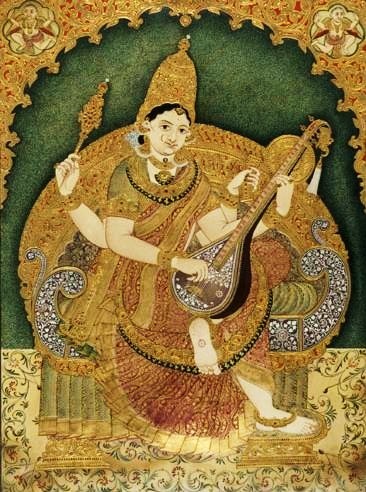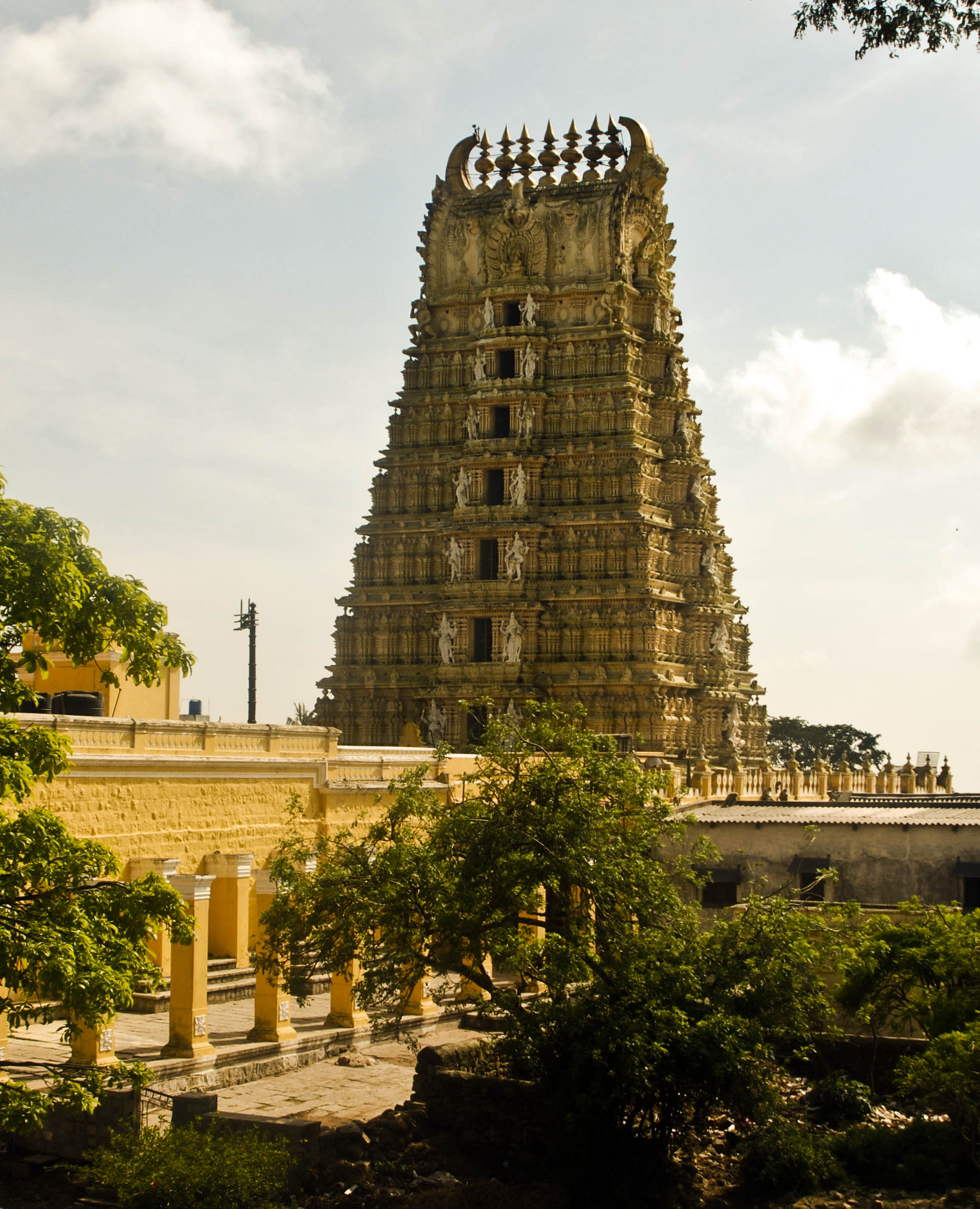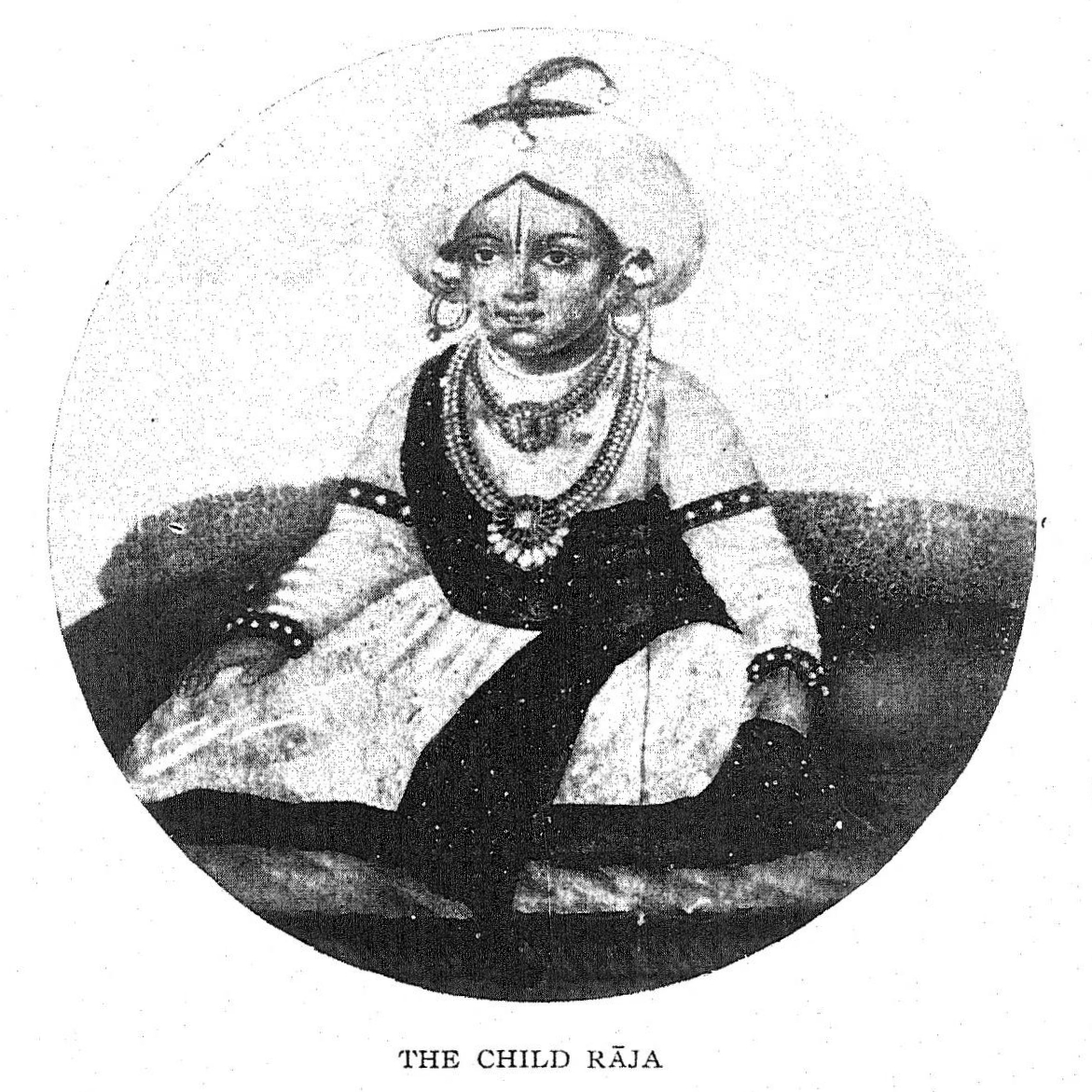|
Mysore Painting
Mysore painting () is an important form of classical South Indian painting style that originated in and around the town of Mysore in Karnataka. The painting style was encouraged and nurtured by the Mysore rulers. Painting in Karnataka has a long and illustrious history, tracing its origins back to the Ajanta Caves period (2nd century BC to 6th century AD). The distinct school of Mysore painting evolved from the paintings during the Vijayanagara Empire period, the rulers of Vijayanagara and their feudatories encouraged literature, art and architecture as well as religious and philosophical discussions. With the fall of the Vijayanagara Empire after the 1565 Battle of Talikota, the artists who were until then under royal patronage migrated to various places such as Mysore, Tanjore and Surpur among others. Absorbing the local artistic traditions and customs, the erstwhile Vijayanagara school of painting gradually evolved into the many styles of painting in South India, including th ... [...More Info...] [...Related Items...] OR: [Wikipedia] [Google] [Baidu] [Amazon] |
Hyder Ali
Hyder Ali (''Haidar'alī''; ; 1720 – 7 December 1782) was the Sultan and ''de facto'' ruler of the Kingdom of Mysore in southern India. Born as Hyder Ali, he distinguished himself as a soldier, eventually drawing the attention of Mysore's rulers. Rising to the post of Dalavayi ( commander-in-chief) to Krishnaraja Wodeyar II, he came to dominate the titular monarch and the Mysore government. He became the ''de facto'' ruler, King of Mysore as Sarvadhikari (Chief Minister) by 1761. During intermittent conflicts against the East India Company during the First and Second Anglo–Mysore Wars, Hyder Ali was the military leader. Though illiterate, Hyder Ali concluded an alliance with the French, and used the services of French workmen in raising his artillery and arsenal. His rule of Mysore was characterised by frequent warfare with his neighbours and rebellion within his territories. This was not unusual for the time as much of the Indian subcontinent was then in turmoil. ... [...More Info...] [...Related Items...] OR: [Wikipedia] [Google] [Baidu] [Amazon] |
Channapatna Toys
Channapatna toys are a particular form of wooden toys and dolls that are manufactured in the town of Channapatna in the Ramanagara district of Karnataka state, India. This traditional craft is protected as a geographical indication (GI) under the World Trade Organization, administered by the Government of Karnataka.GI for Channapatna toys and dolls is mentioned by As a result of the popularity of these toys, Channapatna is known as the ''Gombegala Ooru'' (toy-town) of Karnataka.A brief history of Channapatna toys is provided by Traditionally, the work involved lacquering the wood of the ''Wrightia tinctoria'' tree, colloquially called ''Aale mara'' (ivory-wood).A brief description of Channapatna toys is provided by History The greater prominence of the Channapatna toys can be traced to patronage from Tipu Sultan, the historic ruler of Mysore, though these toys existed before this period historically given as gifts as part of Dusshera celebrations. It is known that he was ... [...More Info...] [...Related Items...] OR: [Wikipedia] [Google] [Baidu] [Amazon] |
Mysore Sandalwood Oil
Mysore ( ), List of renamed places in India, officially Mysuru (), is a city in the South India, southern Indian state of Karnataka. It is the headquarters of Mysore district and Mysore division. As the traditional seat of the Wadiyar dynasty, the city functioned as the capital of the Kingdom of Mysore for almost six centuries (). Known for its List of Heritage Buildings in Mysore, heritage structures, palaces (such as the famous Mysore Palace), and its Culture of Mysore, culture, Mysore has been called the "City of Palaces", the "Heritage City", and the "Cultural capital, Cultural capital of Karnataka". It is the List of cities in Karnataka by population, second-most populous city in the state and one of the List of cleanest cities in India, cleanest cities in India according to the Swachh Survekshan. Mysore is situated at the foothills of the Chamundi Hills. At an altitude of above Sea level, mean sea level, the city of Mysore is geographically located at 12° 18′ 26″ nor ... [...More Info...] [...Related Items...] OR: [Wikipedia] [Google] [Baidu] [Amazon] |
Mysore Sandal Soap
Mysore Sandal Soap is a brand of soap manufactured by the Karnataka Soaps and Detergents Limited (KSDL), a company owned by the government of Karnataka in India. This soap has been manufactured since 1916, when Krishna Raja Wadiyar IV, the king of Mysore, set up the Government Soap Factory in Bangalore. The main motivation for setting up the factory was the excessive sandalwood reserves that the Mysore Kingdom had, which could not be exported to Europe because of the First World War. In 1918, KSDL was incorporated as a company by merging the Government Soap Factory with the sandalwood oil factories at Shimoga and Mysore. Mysore Sandal Soap is the only soap in the world made from 100% pure sandalwood oil. KSDL owns a proprietary geographical indication tag on the soap, which gives it intellectual property rights to use the brand name, to ensure quality, and to prevent piracy and unauthorised use by other manufacturers. In 2006, Mahendra Singh Dhoni, the Indian cricketer was se ... [...More Info...] [...Related Items...] OR: [Wikipedia] [Google] [Baidu] [Amazon] |
Mysore Agarbathi
Mysore Agarbathi is a variety of incense sticks manufactured at Mysore using locally grown ingredients which was found only in state of Karnataka. This incense has been awarded a Geographical Indication tag from the Government of India in 2005, due to its historic background and remote availability of material used. History The making of incense sticks, also called 'agarbathi' in Hindi, became an organised industry in Bangalore during the 1900s and was locally known as oodabathies (blowing fumes). The incense sticks were very simple to manufacture, as it was only a paste of natural ingredients mixed with charcoal and Gijit, and rolled on to bamboo sticks. The proportion of mixing was of main importance. The Maharaja of Mysore patronised the production and promotion of the incense sticks. When they were given a certificate of merit from the Wembley exhibition in London, the Kingdom of Mysore gave the incense sticks as gifts to foreign visitors and guests, to encourage exports to ... [...More Info...] [...Related Items...] OR: [Wikipedia] [Google] [Baidu] [Amazon] |
Mysore Pak
Mysorepak ( , literally, Mysore's confectionery) is a type of mithai (sweetmeat) from India. It is prepared with only three ingredients: ghee, sugar and besan. It originated in the royal kitchen of Kingdom of Mysore. Now Mysore is one of the major cities in the Indian state of Karnataka. It is prepared from generous amount of ghee along with sugar and gram flour more often flovoured with cardamom. The texture of this sweet is similar to both a fudge and a buttery dense cookie. It is also popular in the neighbouring countries Pakistan and Bangladesh (it is known as ''Monsur'' in Bangladesh). History It is prepared as part of wedding meal, also popular during festivals and major events of celebration in southern India. The Maharaja of Mysore, Krishna Raja Wadiyar IV who was a great connoisseur maintained his royal kitchen at the Amba Vilas Palace in Mysore with lots of care and perfection. Kakasura Madappa, one of the chefs known for preparing sweets (sweet master) began e ... [...More Info...] [...Related Items...] OR: [Wikipedia] [Google] [Baidu] [Amazon] |
Ground (art)
In visual arts, the ground (sometimes called a primer) is a prepared surface that covers the support of the picture (e.g., a canvas or a panel) and underlies the actual painting (the colors are overlaid onto the ground). Occasionally the term is also used in a broad sense to designate any surface used for painting, for example, paper for watercolor or plaster for fresco. The main purposes of the ground are to block chemical interactions between the paint and the support and to provide desired texture for painting or drawing. The ground is also used to highlight the colors, and its color and tone affect the appearance of paint levels above, therefore the painters might have individual preferences for the color of the ground: 19th century artists, especially the impressionists, preferred the white ground (first used by J. M. W. Turner), while Rembrandt preferred brownish tones and Poussin the red ones. The oil painting becomes more transparent with age, so to avoid a gradual b ... [...More Info...] [...Related Items...] OR: [Wikipedia] [Google] [Baidu] [Amazon] |
Mysore Painting
Mysore painting () is an important form of classical South Indian painting style that originated in and around the town of Mysore in Karnataka. The painting style was encouraged and nurtured by the Mysore rulers. Painting in Karnataka has a long and illustrious history, tracing its origins back to the Ajanta Caves period (2nd century BC to 6th century AD). The distinct school of Mysore painting evolved from the paintings during the Vijayanagara Empire period, the rulers of Vijayanagara and their feudatories encouraged literature, art and architecture as well as religious and philosophical discussions. With the fall of the Vijayanagara Empire after the 1565 Battle of Talikota, the artists who were until then under royal patronage migrated to various places such as Mysore, Tanjore and Surpur among others. Absorbing the local artistic traditions and customs, the erstwhile Vijayanagara school of painting gradually evolved into the many styles of painting in South India, including th ... [...More Info...] [...Related Items...] OR: [Wikipedia] [Google] [Baidu] [Amazon] |
Serfoji II
Serfoji II (, ) (24 September 1777 – 7 March 1832), also known as Sarabhoji II Bhonsle, was the last sovereign ruler of the Maratha principality of Thanjavur. He ruled from 1787 to 1793, and again from 1798 until his death in 1832. He was adopted by the previous ruler, Thulaja, and was subsequently nominated as his successor. During his reign, administrative powers were transferred to the British East India Company, rendering him and his descendants titular Maharajas of Thanjavur. He belonged to the Maratha Bhonsle dynasty. Serfoji II is remembered for his patronage of art and culture, as well as for his notable contributions to the field of ophthalmology. Early life Serfoji was born on 24 September 1777 into the Bhonsle royal house, a lineage tracing back to Shivaji I. On 23 January 1787, he was formally adopted by King Thuljaji, the then ruler of Thanjavur. His education was entrusted to the Danish missionary Christian Friedrich Schwarz. [...More Info...] [...Related Items...] OR: [Wikipedia] [Google] [Baidu] [Amazon] |
Krishnaraja Wodeyar III
Krishnaraja Wodeyar III (14 July 1794 – 27 March 1868) was an Indian king who was the twenty-second Maharaja of Mysore. He ruled the kingdom for nearly seventy years, from 30 June 1799 to 27 March 1868, for a good portion of the latter period of which he was merely a nominal ruler. He is known for his contribution and patronage to different arts and music during his reign. He was succeeded by his biological grandson and adopted son, Chamarajendra Wadiyar X. Early years Krishnaraja Wodeyar III was born at Srirangapatna to Maharaja Chamaraja Wadiyar IX and his first wife, Maharani Kempananjammani Devi.Annals of The Mysore Royal Family Part-1: A publication by the Royal Family of Mysore: 1916 Maharani Lakshmi Devi, his adoptive grandmother, played a major role in the education and upbringing of her adopted grandson, Krishnaraja Wodeyar III, and was instrumental in his ascent to the throne.Rajakaryaprasakta Rao Bahadur (1936), p265 Since the insurrection of Mysore and storm ... [...More Info...] [...Related Items...] OR: [Wikipedia] [Google] [Baidu] [Amazon] |
Tipu Sultan
Tipu Sultan (, , ''Sultan Fateh Ali Sahab Tipu''; 1 December 1751 – 4 May 1799) commonly referred to as Sher-e-Mysore or "Tiger of Mysore", was a ruler of the Kingdom of Mysore based in South India. He was a pioneer of rocket artillery. He expanded the iron-cased Mysorean rockets and commissioned the military manual ''Fathul Mujahidin''. The economy of Mysore reached a zenith during his reign. He deployed rockets against advances of British forces and their allies during the Anglo-Mysore Wars, including the Battle of Pollilur (1780), Battle of Pollilur and Siege of Srirangapatna (1799), Siege of Srirangapatna. Tipu Sultan and his father Hyder Ali used their French-trained army in alliance with the French in their struggle with the British, and in Mysore's struggles with other surrounding powers: against the Maratha Empire, Marathas, Sira, India, Sira, and rulers of Malabar (Northern Kerala), Malabar, Kodagu district, Kodagu, Keladi Nayaka Kingdom, Bednore, Carnatic regi ... [...More Info...] [...Related Items...] OR: [Wikipedia] [Google] [Baidu] [Amazon] |








